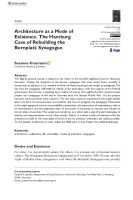Architecture as a Mode of Existence. The Hamburg Case of Rebuilding the Bornplatz Synagogue
Author(s)
Publication Name
Publication Date
Abstract
The filigree ground mosaic is placed at the heart of the Grindel neighbourhood in Hamburg, Germany. Tracing the footprint of the former synagogue that once stood there, proudly, it demarcates an absence. It is a reminder of what the Nazis destroyed and sought to extinguish. The fact that the synagogue will finally be rebuilt, in the same place, with the support of the Federal government and the city, is anything but a matter of course. This will be the first reconstruction project of a synagogue of this size in Germany since the Second World War. Yet the project has been controversial in some respects. The two main concerns expressed in the public debate about the form of reconstruction and whether and how to integrate the Synagogue Monument at first sight appeared to be in irreconcilable competition: the importance of maintaining a culture of remembrance, and the legitimate claim of the Jewish Community to recover and rebuild its former place of worship. This would not merely be, as is often said, a sign of Jewish belonging, of identity and representation, in the urban society. Rather, it is about modes of existence that the architecture itself, in the materiality of its form and its presence, embodies and makes possible. To the people, architecture is what makes the difference. It thus shapes the political landscape.
Topics
Genre
Geographic Coverage
Copyright Info
Creative Commons https://creativecommons.org/licenses/by-nc/4.0/
Original Language
DOI
Bibliographic Information
Architecture as a Mode of Existence. The Hamburg Case of Rebuilding the Bornplatz Synagogue. 2024: https://archive.jpr.org.uk/10.1177/17499755241260761




